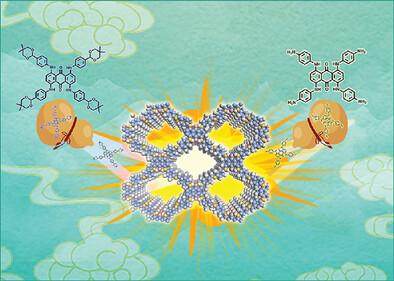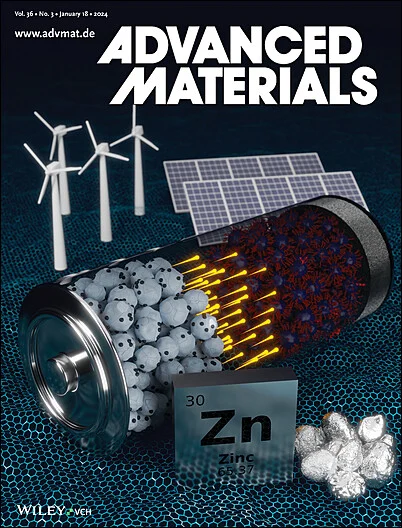Redox-Bipolar Covalent Organic Framework Cathode for Advanced Sodium-Organic Batteries
IF 27.4
1区 材料科学
Q1 CHEMISTRY, MULTIDISCIPLINARY
引用次数: 0
Abstract
Redox-active covalent organic frameworks (COFs) are promising candidates for sodium-ion batteries (SIBs). However, the construction of redox-bipolar COFs with the anions and cations co-storage feature for SIBs is rarely reported. Herein, redox-bipolar COF constructed from aniline-fused quinonoid units (TPAD-COF) is developed as the cathode material in SIBs for the first time. The unique integration of conductive aniline skeletons and quinone redox centers endows TPAD-COF with high ionic/electrical conductivity, abundant redox-active sites, and fascinating bipolar features. Consequently, the elaborately tailored TPAD-COF cathode exhibits higher specific capacity (186.4 mAh g−1 at 0.05 A g−1) and superior cycling performance (over 2000 cycles at 1.0 A g−1 with 0.015% decay rate per cycle). Impressively, TPAD-COF also displays a high specific capacity of 101 mAh g−1 even at −20 °C. As a proof of concept, all-organic SIBs (AOSIBs) are assembled using TPAD-COF cathode and disodium terephthalate anode, which also show impressive electrochemical properties, indicating the potential application of TPAD-COF cathode in AOSIBs. The work will pave the avenue toward advanced COFs cathode for rechargeable batteries through rational molecular design.

用于先进钠-有机电池的氧化还原-双极共价有机框架阴极
氧化还原活性共价有机框架(COF)是钠离子电池(SIB)的理想候选材料。然而,为钠离子电池构建具有阴阳离子共储功能的氧化还原双极 COF 的研究却鲜有报道。本文首次开发了由苯胺融合类醌单元构建的氧化还原双极 COF(TPAD-COF),作为 SIB 的阴极材料。导电苯胺骨架和醌氧化还原中心的独特结合赋予了 TPAD-COF 高离子/导电性、丰富的氧化还原活性位点和迷人的双极特性。因此,精心定制的 TPAD-COF 阴极具有更高的比容量(0.05 A g-1 时为 186.4 mAh g-1)和卓越的循环性能(1.0 A g-1 时超过 2000 个循环,每个循环的衰减率为 0.015%)。令人印象深刻的是,TPAD-COF 即使在零下 20 °C,也能显示出 101 mAh g-1 的高比容量。作为概念验证,使用 TPAD-COF 阴极和对苯二甲酸二钠阳极组装的全有机 SIB(AOSIB)也显示出令人印象深刻的电化学特性,表明 TPAD-COF 阴极在 AOSIB 中的潜在应用。这项工作将为通过合理的分子设计将先进的 COFs 阴极用于可充电电池铺平道路。
本文章由计算机程序翻译,如有差异,请以英文原文为准。
求助全文
约1分钟内获得全文
求助全文
来源期刊

Advanced Materials
工程技术-材料科学:综合
CiteScore
43.00
自引率
4.10%
发文量
2182
审稿时长
2 months
期刊介绍:
Advanced Materials, one of the world's most prestigious journals and the foundation of the Advanced portfolio, is the home of choice for best-in-class materials science for more than 30 years. Following this fast-growing and interdisciplinary field, we are considering and publishing the most important discoveries on any and all materials from materials scientists, chemists, physicists, engineers as well as health and life scientists and bringing you the latest results and trends in modern materials-related research every week.
 求助内容:
求助内容: 应助结果提醒方式:
应助结果提醒方式:


